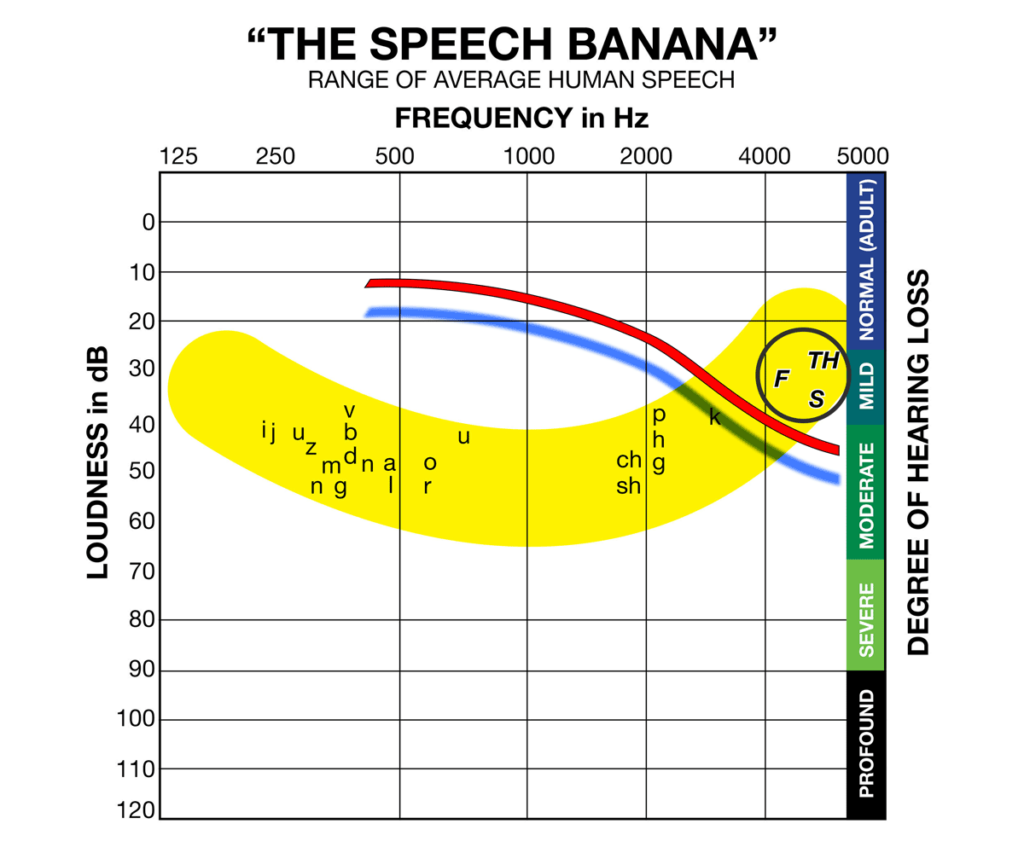It is a common complaint: “I can hear everything OK…but, sometimes I am having a hard time understanding certain words”. This can be a bit confusing as you might think you have hearing loss.
Hearing loss ranges from mild to profound and can be different for each ear.
Human hearing is more complex than we might think. It requires both ears to accurately receive sound waves and then have the brain to decode what is heard into recognizable patterns. Lot’s of issues can develop along this pathway and both the symptoms and the level of hearing loss is variable. Mild and moderate hearing loss, especially in the higher frequencies, is the most common. This presents a particularly deceptive form of hearing loss. In fact, the only symptom of the hearing loss might be with understanding particular words. Many clients report that this gets worse in in noisier environments.
Even the mildest hearing loss can make it difficult to understand certain words in noisy environments.
 Hearing and Understanding Speech
Hearing and Understanding Speech
As you can see in the diagram above, an audiogram is a very simple chart with frequency (pitch) increasing left to right and sound intensity (volume) increases we go from top to bottom. Note the scale on the left side increase top to bottom. You can also look at the audiogram showing how the degree of hearing loss increases as we go from the top to the bottom of the audiogram because the sound intensity has to be increased to be heard. We’ll explain the importance of the yellow “speech banana” pattern on the audiogram in a minute.
High Frequency Hearing Loss
Looking at the audiogram, the red and blue lines represent the minimum sound level boost needed to be heard in the right and left ear respectively. The lines are relatively flat to the left of 1,000 Hz and then slide downward as the frequencies tested increase. When the red and blue lines pass the 2,000 Hz frequency, we consider this area as being high frequency. This “sloping hearing loss” is also known as high frequency hearing loss. This explains why lower pitched sounds such as drums, or a bass guitar is easy to hear clearly, but anything high in pitch such as a flute is difficult.
It is important to note that even though the hearing loss shown above is getting progressively worse with the increase in frequency, this doesn’t mean the high frequency sounds can’t be heard without some amplification.
High frequency hearing loss often causes the feeling of being able to hear but not being able to understand each word equally.
Understanding & The Speech Banana
Looking at the yellow area (the speech banana) of the audiogram, our ability to hear vowel sounds (A, E, I, O, U) rely on our low pitch hearing. As we move to the higher frequencies on the right side of the banana, our ability to understand consonant sounds (S, F, Th, Sh, V, K, P etc.) begins to rely more on our high pitch hearing.
As high frequency hearing loss increases, a person’s ability to hear subtle differences between consonants drops off. Over time recognizing the difference between similar sounding words such as “hat” and “fat” can become an issue. Note the circle around the "F" "Th" S" vs the "H" appearing to the left at 2,000 Hz. Mixing up the consonants can make understanding even a simple statement or question difficult. Some examples of words that are confusing: fall with fail, sell with sail and puff with though.
In my experience people may catch the second syllable but their brain will just try to compensate with what they think they should be hearing
Hearing Subtle Differences Between Words
The video below shows off how hearing ability at different frequencies can change how we interpret the sounds our ears pick up. When you listen to the video, people will hear either "Yanny" or "Laurel". Analysis of the sound frequencies has confirmed that both sets of sounds are present in the mixed recording, but some users focus on the higher tinny frequency sounds in "Yanny" and can't seem to hear the lower sounds of the word "Laurel".
Why High Frequency Hearing Loss isn’t Noticed
Most hearing loss takes place over a long period of time and typically goes unnoticed as the brain tries to compensate and filter as best as it can. This extra processing effort places a stress on people that can cause any number of other symptoms and even changes in behavior. Most notably depression and becoming withdrawn.
How Do I Know If I Have High Frequency Hearing Loss?
Understanding speech is usually the first indicator something may be wrong. First it may only be a problem in noisy environments and then eventually quiet environments too. Also, people note that higher pitched voices such as children’s voices may be come difficult to hear.
The only way to truly know if hearing loss is causing a person to have difficulty understanding some words is to have a hearing screening that includes a hearing test. The screening will rule out other possible issues and the hearing test will pin point the area that needs improvement. Luckily, this type of hearing loss is one of the most easily treatable and has high satisfaction rates. To book an appointment, give us a call (204) 788-1083 or contact us online.


 Hearing and Understanding Speech
Hearing and Understanding Speech